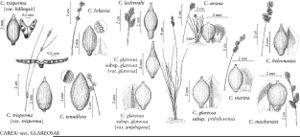Carex tenuiflora
Kongl. Vetensk. Acad. Nya Handl. 24: 147. 1803.
Plants loosely cespitose; rhizomes long, slender. Culms ± erect, weak, 10–50 cm. Leaves: sheaths pale-brown abaxially, inner band hyaline, concave at summit; ligules as long as wide; blades pale green, flat or channeled, 5–15 cm × 0.5–2 mm. Inflorescences erect, ovoid or suborbicular, 0.6–1.2 cm × 4–9 mm; proximal bracts scalelike, sometimes bristlelike, shorter than inflorescences. Spikes 2–4, gynecandrous, closely approximate, containing 3–15 perigynia, short-oblong, 4–9 × 3–6 mm. Pistillate scales white-hyaline with green, 3-veined center, ovate, subequal to perigynia, apex obtuse. Perigynia appressed-ascending, gray-green, obscurely few-veined, obovate-elliptic, 3–3.5 × 1.5–1.75 mm, subcoriaceous; beak absent or nearly so. Achenes pale-brown, oblongelliptic, 1.5–2 × 1.25 (–1.5) mm, glossy. 2n = 58.
Phenology: Fruiting May–Aug.
Habitat: Mires, especially sphagnum bogs, wet woodlands, lowlands
Elevation: 0–1400 m
Distribution

Alta., B.C., Man., N.B., Nfld. and Labr., N.W.T., Ont., P.E.I., Que., Sask., Yukon, Alaska, Colo., Maine, Mass., Mich., Minn., Mont., Ohio, N.Y., Vt., Wis., n Eurasia
Discussion
Selected References
None.
Lower Taxa
"shortened" is not a number.
